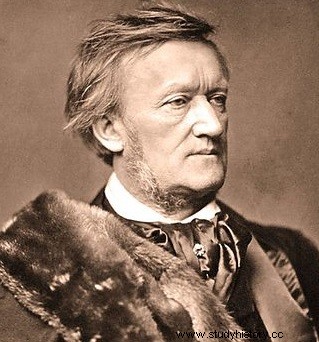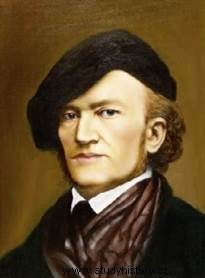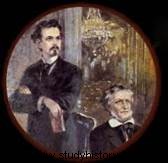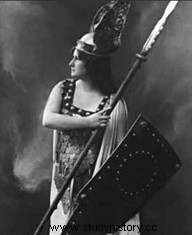 Richard Wagner (1813-1883) is a German composer famous worldwide for his operas. The particularly rich and brilliant Germanic dramatic art of the 19th century was to find with this author one of the most powerful expressions of romantic genius. Its supremacy asserts itself with brilliance, its influence will upset all European music. A vast synthesis encompassing all the arts, Wagner's work appears as the point of convergence where the artistic aspirations and aesthetic trends of his time crystallized. His anti-Semitic positions and his glorification of German art would have a notable influence on the Nazi regime.
Richard Wagner (1813-1883) is a German composer famous worldwide for his operas. The particularly rich and brilliant Germanic dramatic art of the 19th century was to find with this author one of the most powerful expressions of romantic genius. Its supremacy asserts itself with brilliance, its influence will upset all European music. A vast synthesis encompassing all the arts, Wagner's work appears as the point of convergence where the artistic aspirations and aesthetic trends of his time crystallized. His anti-Semitic positions and his glorification of German art would have a notable influence on the Nazi regime.
The early years of Richard Wagner
Wilhem Richard Wagner was born in Liepzig on May 18, 1813 and grew up in the atmosphere of the theater, his mother having married the actor Ludwig Gayer in his second marriage, which gave rise to the idea of becoming a playwright. He pursues brilliant classical studies with a passion for drama and poetry, but his admiration for Carl Maria von Weber and Ludwig von Beethoven directs him towards music, which he will learn as an autodidact. He enrolled at the University of Liepzig in 1831 and created his first opera "Les Fairies" followed by "La Défense d'Aimer".
 While he was choirmaster in Würzburg in 1833 and conductor at the Magdeburg opera in 1834, Wagner had his first operas performed (Les Fées and La Défense d'aimer based on Measure for Measure by Shakespeare), but these were shunned by the public.
While he was choirmaster in Würzburg in 1833 and conductor at the Magdeburg opera in 1834, Wagner had his first operas performed (Les Fées and La Défense d'aimer based on Measure for Measure by Shakespeare), but these were shunned by the public.
The flight and the dark years
In 1834 appointed musical director in Madebourg he met the singer Wilhemine Planner nicknamed Minna whom he married in 1836. He conducted the orchestra of the Liepzig theater then came to Paris in 1837 to 1839 where Mayerber triumphs. In Dresden, where he lived for six years, his opera Rienzi was a great success. It was in 1840 that he composed two of his masterpieces:"The Phantom Ship" and "Tannhäuser.
Compromised in the revolutionary movement of 1848, he had to go into exile in Paris and then in Zurich. Wagnerian compositions are the ultimate testimony to a vision of the world that claims to be the heir to ancient Greek theater as well as Shakespeare and German romantic theatre. They also express the desire to make us listen to a new musical language that fits perfectly with other arts.
His opera Lohengrin was conducted by his friend Franz Litz in Weimar in 1850. Abandoned by his wife, destitute, he was hosted by an admirer Otto von Vesendonck whose wife Mathilde poet and writer was for Wagner a source of inspiration allowing him to create Tristan and Isolde based on the theme of impossible love. The presentation of de Tannhäuser in 1861 caused a scandal. The opera "The Mastersingers of Nurenbreg" was undoubtedly Wagner's most joyous and least tormented work.
The influence of Ludwig II of Bavaria
Accessing the throne in 1864, King Ludwig II of Bavaria, a fervent admirer of Wagner, brought him to Munich, settled his debts and appointed him conductor at the Munich theatre. The King of Bavaria, passionate about his music, puts at his disposal all the human and financial means necessary for the representation of his works. Thanks to his generous help, the famous theater of Bayreuth will later be created, under the direction of the artist, inaugurated in 1876 with the "Ring of Nibelung" in the presence of the elite of the whole world.
 Separated from Minna since 1862, Wagner will create a great scandal by posting his affair with the daughter of Franz Litz, Cosima wife of the conductor Hans von Bülow with whom he will have an illegitimate daughter named Isolde. Falling out of favor among the members of the court, Wagner was forced to leave the court, but his works were donated at the insistence of Louis II. Cosima having divorced, she was able to marry Wagner in 1870 and received “L'ydille de Siegfried” as a gift. Two other children were born to the couple, Eva and Siegfried.
Separated from Minna since 1862, Wagner will create a great scandal by posting his affair with the daughter of Franz Litz, Cosima wife of the conductor Hans von Bülow with whom he will have an illegitimate daughter named Isolde. Falling out of favor among the members of the court, Wagner was forced to leave the court, but his works were donated at the insistence of Louis II. Cosima having divorced, she was able to marry Wagner in 1870 and received “L'ydille de Siegfried” as a gift. Two other children were born to the couple, Eva and Siegfried.
Portrait of Richard Wagner
The face of the master reveals a broad forehead, a protruding nose, a willful chin and piercing eyes. His life offers the spectacle of an extraordinarily turbulent existence troubled by the succession of political events to which he will actively contribute. The activity of his thought is disconcerting by the diversity of the subjects to which it applies:politics, philosophy, social questions, history and legend, general or musical aesthetics occupied Wagner successively or jointly, whereas the musician went on with his task.
Writing long poems, sketching sketches of dramas, devoting himself to the immense labor of orchestral scores, a great thinker and a great musician, he lived only for his art. Wagner, a man of genius with a powerful personality, was considered the spokesperson for German thought of his time.
Artist tormented throughout his life, dogged by money problems, a great lover of women, he died of a heart attack in Venice in 1883 and was repatriated to Bayreuth. He rests in the garden of his villa in Wahnfried in a vault prepared by him, without inscriptions or ornaments.
Unappreciated in its early days, Wagner's work sees its influence spread little by little, especially the lyrical performances in Bayreuth where the influence of his theater will be considerable, particularly in France. Wagner's musical drama is an integral drama realizing the most complete synthesis of all the particular arts:poetry and music, mimicry and plastic. This is why Wagner appears as the culmination of a long evolution, the sovereign genius which produces the work expected, dreamed of and prepared by previous ages. It is also the origin of a renovated scenic art where future creators will be able to discern the vitality of the perpetual becoming that is in it.
Literary works, lyrical works
 Wagnerian compositions are the ultimate testimony to a vision of the world that wants to be heir to both Greek theater ancient than Shakespeare and the German romantic theatre. They also express the desire to make us listen to a new musical language that fits perfectly with other arts.
Wagnerian compositions are the ultimate testimony to a vision of the world that wants to be heir to both Greek theater ancient than Shakespeare and the German romantic theatre. They also express the desire to make us listen to a new musical language that fits perfectly with other arts.
His most famous works are:"Art and Revolution (1849)" "The Work of Art of the Future" "Judaism in Music" (1850) "Opera in Drama" (1851) was one of the most important expressing the musician's theories on anti-Semitic art.
His lyrical works:The "Fairies" and "The Defense of Love" are inspired by Italian and French traditions. Premiered in Dresden in 1840, the opera Renzi contains the germ of what Wagner would once again bring to lyrical drama with brilliant instrumentation and the return of characteristic themes. Through the creation "the ghost ship" Wagner finds in the legend of the Dutchman Henri Heine an idea that is dear to him:redemption through love.
With Tannhäuser (1845) he once again asserts his mastery, his analysis becomes more precise and amplified (this opera is close to the historical opera). "The Ring of the Nibelungen" is a tetralogy whose first three parts "The Rhinegold" "The Walkirie" and "Siegfied" were completed in 1857, while "The Twilight of the Gods" dates from 1872. "Parsifal" created in 1882 constitutes his true musical testament.
Bibliography
- My life, autobiography by Richard Wagner. Classic Folio, 2013.
- Richard Wagner. His life, his work, his century by Martin Gregor-Dellin. Fayard, 1991.
- French Wagnerian Bibliography (1850-2007):Critical bibliography of the literature devoted to Richard Wagner, his work and Wagnerism, written or translated into French by Pascal Bouteldja . The Harmattan, 2008.
To go further
- Richard Wagner:Der Ring des Nibelungen (The Ring of the Nibelung) - 8 DVD box set
